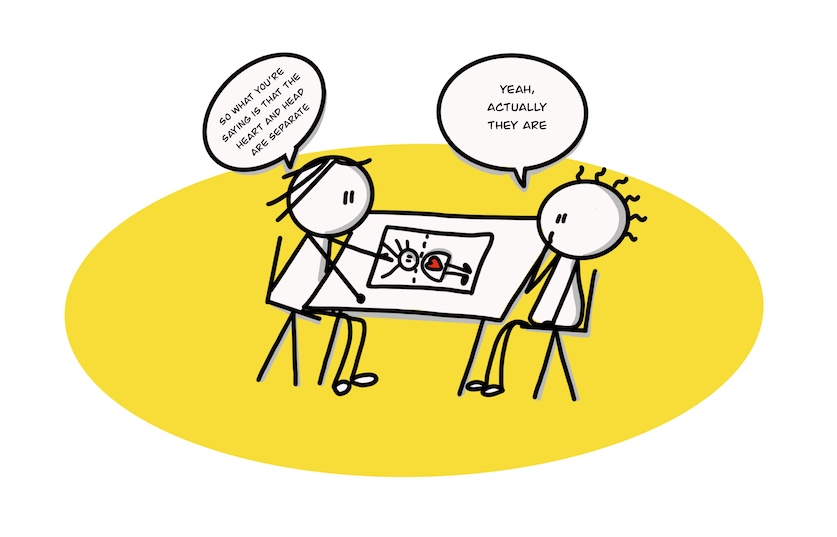Five reasons to use drawing in therapy and coaching

I have over ten years of work experience as an art therapist with various target groups in mental health care. I use this experience in the trainings I give at Draw Your Message. From my perspective, I describe below five important reasons to use drawing in therapy and coaching.
1. Overview
Using drawings from a bird’s-eye view, lifelines, and schematic representations can help a client to take a step back from a situation or event. This can be helpful when a client is overwhelmed by emotion, providing distance and perspective. It allows you and the client to look at the problem together. It creates a sense of distance and often brings about calmness and stability.
2. Insight
Just as drawing assignments can create distance, they can also increase insight. You can zoom in on lifelines, asking questions like, “Okay, at what exact moment in your childhood did you experience that intense situation? Which moment was the most difficult? What were your thoughts, feelings, and behaviors at that moment?” This way of working is very therapeutic, and I have used it extensively in trauma processing, for example, after abuse or war. Zooming in, again and again, helps regain control (learning to look instead of avoiding thoughts) and smooth out the sharpest edges.
You can also zoom in on emotions. “If you feel anger, what does that look like for you (your anger is different from mine), and how does your mother see your anger? You can give anger a color, a texture, a rhythm, a certain pressure, a material, a size. Is the anger you say you feel in your stomach round or sharp? Does it have a color? Does your anger move? Is it light or heavy?” By giving shape to anger, it becomes concrete, and the client can feel validated and seen. By the way, these types of assignments are not only for children! Parents or adults can also benefit from them. I have asked a father, as an art therapist, to represent his anger in a similar way because I knew his son perceived it as something very big and scary. By placing the two different images side by side and discussing them with the father and son, insight and a meaningful conversation emerged.
3. Looking forward
We all know that having a clear picture of goals can be immensely helpful. By creating a drawing or collage of where someone ultimately wants to be, it becomes even clearer which aspects need to change to get there. Moreover, it helps to focus on something positive. The more a positively formulated goal lives, the more it motivates.
4. Clarifying Situations, Steps, and Phases
Through storytelling, lifelines, or visual life stories, you bring clarity to the sequence of events. Situations are put back in their place. Something still has an influence, but it is already in the past and that’s where it belongs!
For example, “Both of you, create a comic book of the morning as you experienced it. I’m curious about what caused the anxiety to suddenly escalate so quickly. For instance, on such a comic book, you can already see that while the mother was still in bed, she was checking her work emails and immediately became stressed. The son was already angry because the mother hadn’t prepared his lunchbox (as agreed), and then when the little sister dropped the jar of peanut butter, the brother started screaming, then the mother shouted at the son, and in response, the son shouted back at the mother. “Aha… so a lot is happening on both sides?!” This way of working can increase mutual understanding and clarify which agreements need to be made to prevent similar situations in the future. By placing events and processes in a pattern, the pattern becomes very visible to the client, and you can indicate in the drawing where the possibilities for change lie, thereby breaking the pattern.
5. Visual Report
By giving the client the drawing at the end of the session or taking a photo of it, you provide a kind of minutes. The drawing can serve as a tool for the client at home when discussing the session with someone else, such as parents who want to know what was discussed.
Furthermore, repeatedly looking back at the drawing can enhance the impact of the session as the client can better absorb what was said and done. It can also help to ask the client to review the drawing just before the next session. How often does it happen that a client has no idea what was discussed last time? By having the client review the drawing, you can pick up right where you left off.
Discover the power of visual communication with Draw your message!
By using simple, expressive drawings, you too can effectively convey your message. Business drawing, also known as visual communication, is a method that is becoming increasingly popular. Draw your message offers workshops and training in business drawing to teach you how to say more with just one image than with a thousand words. See dates of upcoming workshops here or check out our book Conversations visualized specifically for Counselors, practitioners and other care providers.
